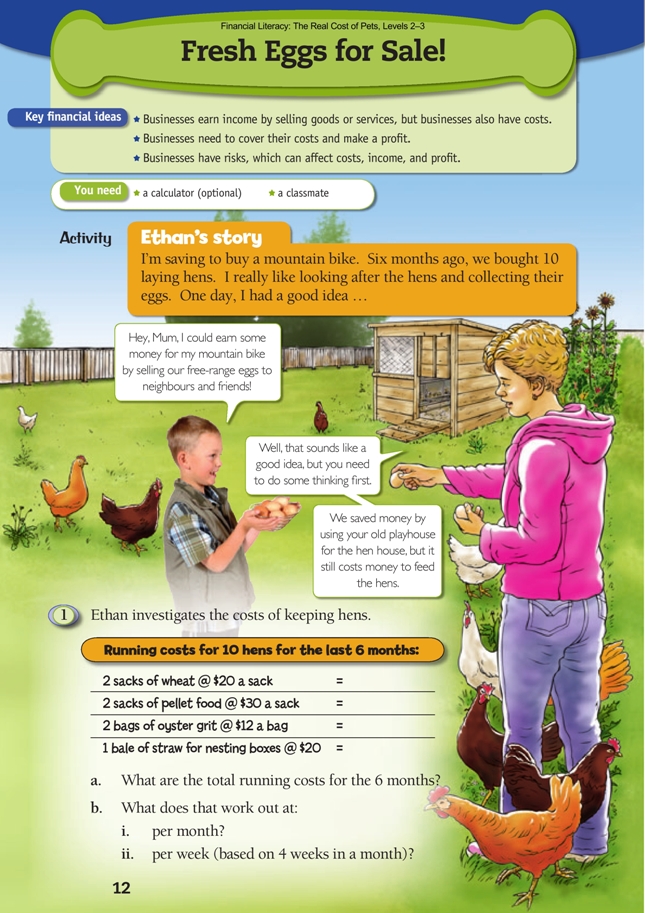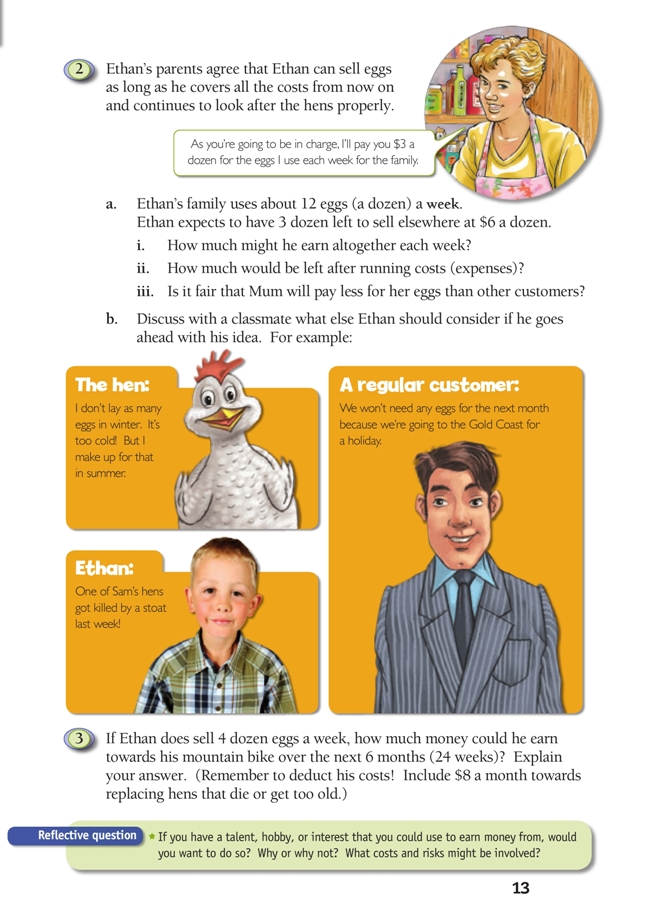This is a level 3 number and algebra activity from the Figure It Out series. It relates to Stage 6 of the Number Framework.
A PDF of the student activity is included.
Click on the image to enlarge it. Click again to close. Download PDF (1906 KB)
use additive strategies to calculate costs
use division to calculate costs per month and per year
use multiplication to calculate money earnt
Number Framework Links
Students at stage 5 could work independently using a calculator or other materials like numeracy money after the problems in this activity have been explained. Students at stage 6 should be able to use various numeracy strategies to solve the problems in this activity independently. (See the table of NDP material on page 4.)
FIO, Levels 2-3, Financial Literacy: The Real Cost of Pets, Fresh Eggs for Sale! pages 12-13
A classmate
Financial understanding
In this activity, Ethan learns that there are lots of aspects to consider when starting up a small business and that even though he can sell his products to help meet his goal (saving enough money to buy a mountain bike), there are expenses to cover as well as risks to think about. Risks need to be considered before making a financial
decision.
Ethan matches his capabilities with setting up a business that involves something he enjoys doing, and he identifies, assesses, and manages risks associated with the business. With this approach, Ethan is more likely to be successful and meet his goals.
Ensure that the students know the meaning of terms such as costs, income, and profit as well as the numerical value of a dozen, the meaning of @, and how many days/weeks are in a month.
As an introduction, the class could share their knowledge of the different types of eggs available, for example, barn/battery/free range, and discuss why people pay higher or lower amounts depending on their choice of egg type and why the eggs are priced differently. (An Internet search engine using “eggs + price” or “eggs + cost”
may provide some interesting points for debate.)
Mathematics and statistics
This activity involves a fair amount of calculating, quite apart from the financial literacy discussion. If you are using this activity with your whole class, the students at stages 2 and 3 will need teacher support, materials, and calculators to complete mathematical aspects and may also need the numbers modified for the mathematics to be meaningful. The students at stage 4 will also need teacher assistance, materials, and the use of calculators to complete the mathematical tasks.
The students could use numeracy money for question 1a, but a more efficient strategy would be to use doubles.
The students may require materials to complete question 1b; money would be helpful, as would paper strips with money amounts written on them. The students could also use diagrams to show how they are working it out, although stage 6 students could be using working form.
Question 3 is a multi-step problem; you may need to elaborate on these steps before the students attempt to solve it. As an extension, able students could work out how much difference there is in the totals if they use the number of weeks there actually are in 6 months as opposed to the 4 weeks in a month given as a guide in the
question.
Reflective question
Financial understanding
The reflective question should prompt some lively discussion. It’s important for the students to understand that not all pets, hobbies, and interests can or should make money for their owners. Many people choose to spend some of their earnings on pets, hobbies, and interests without expecting or wanting to earn money from them.
Others may earn some money, for example, selling plants from their garden or fish from their tanks, but they usually spend that money on more stock, equipment, or improvements and are not involved just for profit or to make money to pay other living expenses. People who win prizes through amateur sports, such as horse shows
or golf, have usually spent more than the prize value in entry fees, travel, and accommodation.
Further investigations and tasks
The students could:
• research who can have hens and who cannot. Why? What about roosters? Who makes these rules? How can they be changed? Why are people who work with poultry not allowed to keep poultry at home?
• research what they could do/make from home that could make income for them, for example, set up a lemonade stall, grow plants, make bird tables, organise games, make compost, and so on. If they were to earn money doing something that they were interested in, what might they do with that money?
• discuss with grandparents or elderly neighbours whether they and/or their parents had poultry or produced fruit and vegetables when they were growing up.
• discuss ways for Ethan to replace his hens after 3–4 years. What would be the best way for him to plan for this event? Would it be better for him to buy in pullets or to get some fertile eggs and hatch them? (You could use a plus, minus, interesting [PMI] evaluation for these options.) What could Ethan do if he were allowed to have a rooster?
Social Sciences Links
Achievement objective:
• Understand how people make choices to meet their needs and wants (Social Studies, level 2)
The students could discuss what impact Ethan’s “want” or goal has on his choices. They could also discuss what the hens’ needs and wants are.
Other Cross-curricular Links
Technology achievement objective:
• Brief development: Explain the outcome they are developing and describe the attributes it should have, taking account of the need or opportunity and the resources available (Technological Practice, level 2)
The students could:
– design and make a container for Ethan’s eggs
– suggest ways to recycle or reuse egg cartons. You could use different coloured plastic pots to make this fun: the students’ suggestions go into one pot (for example, a purple pot) and are then pulled out and categorised, using other coloured pots, as good, bad, problematic, and so on.
Science achievement objective:
• Life processes: Recognise that all living things have certain requirements so they can stay alive (Living World, level 2)
The students could investigate:
– what hens require in order to be happy, healthy creatures
– the nutritional value of eggs.
Health and Physical Education achievement objective:
• Safety management: Identify risk and use safe practices in a range of contexts (Personal Health and Physical Development, level 2)
The students could investigate what diseases can be passed from humans to poultry and vice versa and how to protect both species from the spread of disease.
Answers to Activity
1. a. $144. ($40 + $60 + $24 + $20)
b. i. $24. ($144 ÷ 6)
ii. $6. ($24 ÷ 4 or $144 ÷ 24 weeks)
2. a. i. $21. ($3 + [3 x $6])
ii. $15. ($21 – $6)
iii. Answers may vary. Ethan will be eating some of the eggs, and his parents have
paid for all the set-up costs and food for the first 6 months.
b. Answers will vary. Hens lay fewer eggs in winter, so Ethan won’t be able to sell as
many over that time. Hens can get sick or die. His customers may not always want to
buy eggs every week. Ethan will need to trade off his free time to look after the hens
and collect and deliver the eggs.
3. Based on 4 weeks per month = 24 weeks, Ethan could earn approximately $312. From 4 dozen eggs a week (including the dozen to his mother), he will earn $504 ($21 x 24 weeks). His costs will be $192 ($6 per week x 24 weeks for running costs = $144 plus $8 a month towards replacing the hens, $8 x 6 = $48.
$504 – $192 = $312
Reflective question
Answers will vary. You may think about what you are good at, for example, baking, fixing things, breeding pets, and what other people need or want and would be prepared to pay a price for. If there is a match and the costs are less than the income,
then a talent, hobby, or interest could be used to set up a business and make a profit. Costs include set-up and materials used. The risks are that it may cost you more to set up, make the product, or run the business than you get from sales or as payment.
You also need to take into account the time spent trying to make money instead of enjoying free time, such as after school or school holidays

